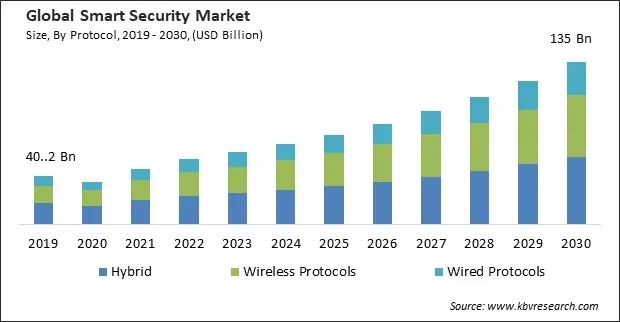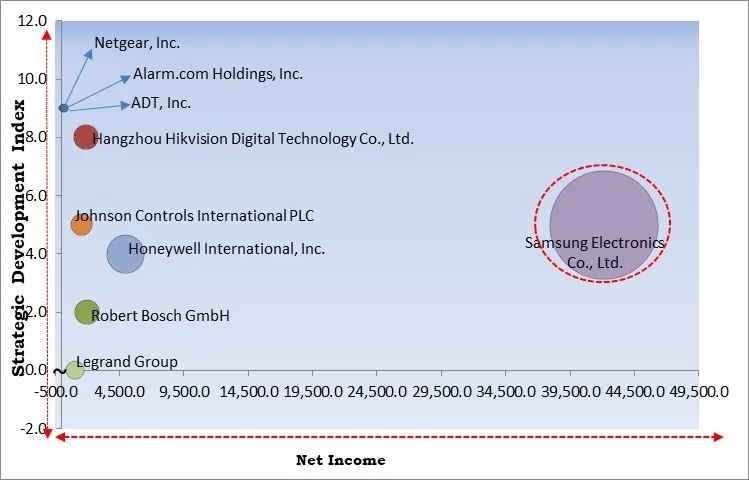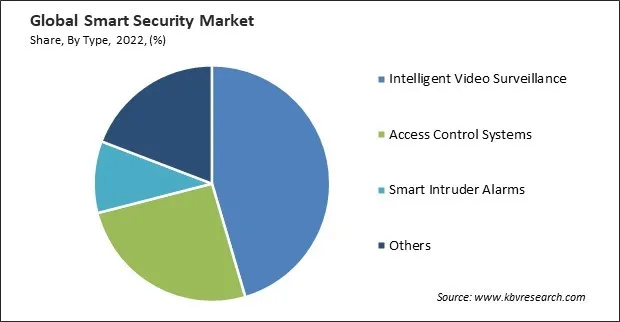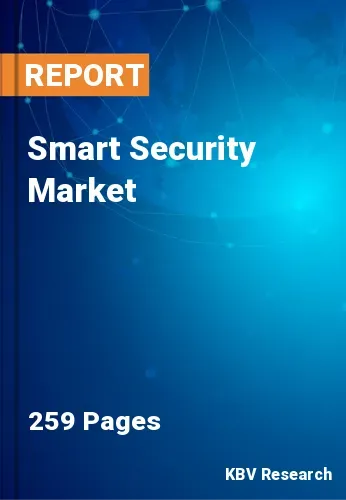The Global Smart Security Market size is expected to reach $135 billion by 2030, rising at a market growth of 12.2% CAGR during the forecast period.
The concept of smart homes has gained widespread acceptance in North America. Technological innovation is highly concentrated in this region, and developments in AI and the IoT have propelled the proliferation and acceptance of these solutions and cloud computing. Consequently, the North American region would acquire nearly 30% of the total market share by 2030. North America has high internet penetration rates, facilitating the adoption of connected and cloud-based security solutions.

The major strategies followed by the market participants are Product Launches as the key developmental strategy to keep pace with the changing demands of end users. For instance, in December, 2023, Hangzhou Hikvision Digital Technology Co., Ltd. released a range of anti-corrosion cameras. The cameras in the range feature Hikvision’s Colorvu and Darkfighter technologies for delivering high-quality full-color images. Additionally, the cameras are built with lightweight polymer materials that allow them to withstand corrosion. Moreover, in November, 2023, Netgear, Inc. announced the launch of NETGEAR MS108TUP 8-Port Multi-Gigabit (2.5G) Ethernet Ultra60 PoE++Smart Switch. The switch features four PoE++ ports and multi-gigabit (2.5G) ports. Furthermore, it comes with IPv6 management and Access Control Lists (ACLs) for enhanced network performance.
Based on the Analysis presented in the KBV Cardinal matrix; Samsung Electronics Co., Ltd. is the forerunner in the Market. In June, 2019, Samsung Electronics introduced the SmartThings Cam. This camera has been designed to help the families keep an eye on what matters most at home. SmartThings Cam is a smarter way to monitor home with premium monitoring features at an approachable price. Companies such as Honeywell International, Inc., Hangzhou Hikvision Digital Technology Co., Ltd. and Robert Bosch GmbH are some of the key innovators in Market.

Video surveillance is a deterrent to criminal activities and helps prevent security breaches. The visible presence of cameras can discourage unauthorized access, theft, and vandalism, contributing to a safer environment. Video surveillance is a crucial component of urban security and smart city initiatives. It helps monitor public spaces, traffic, and critical infrastructure, contributing to public safety and emergency response efforts. Retailers use video surveillance for loss prevention, inventory management, and monitoring customer behaviour. The market is expanding significantly due to the growing demand for video surveillance.
Rapid urbanization is leading to the development of smart cities, which rely on integrated and intelligent security systems. The need for enhanced security in urban areas, including public spaces and critical infrastructure, is propelling the adoption of these technologies. Urban expansion results in heightened levels of construction and development, encompassing commercial and residential spaces. These solutions, such as access control, video surveillance, and intrusion detection, are adopted to secure buildings and properties. Urbanization facilitates the integration of Internet of Things (IoT) devices and data analytics into these systems. These technologies provide real-time insights, predictive analytics, and actionable intelligence for better decision-making in urban security management. Expansion of urbanization has been a pivotal factor in driving the growth of the market.
Integrating various devices and systems from different manufacturers can be challenging. Compatibility issues between devices, protocols, and platforms may hinder seamless integration, leading to fragmented security setups. Incompatibility between devices may lead to vendor lock-in, where users depend on a specific vendor's ecosystem. This can limit flexibility and choice, making it challenging for users to switch or upgrade components without significant effort and cost. Integration and compatibility issues are a significant challenge that hampers the growth of market.
Based on protocol, the market is classified into wireless protocols, wired protocols, and hybrid. The wireless protocols segment acquired a substantial revenue share in the market in 2022. Wireless security systems are well-suited for temporary or mobile applications. This is particularly useful in construction sites, event venues, or other temporary locations where rapid deployment and flexibility are essential. Wireless devices often incorporate energy-efficient features, such as low-power modes and the ability to adjust power consumption based on usage. This increases energy efficiency and is consistent with sustainability objectives.
By type, the market is categorized into smart intruder alarms, intelligent video surveillance, access control systems, and others. The smart intruder alarms segment covered a considerable revenue share in the market in 2022. Smart intruder alarms can be integrated with video surveillance systems. This integration enhances situational awareness. Geofencing technology allows users to set virtual boundaries around their property. Convenience is enhanced by the smart intruder alarm's ability to arm or disarm automatically when a user's mobile device enters or exits the geofenced area. When a security breach is detected, smart intruder alarms provide real-time alerts and notifications to homeowners or businesses. This immediate notification allows quick responses and can help prevent or minimize potential losses.

On the basis of application, the market is divided into commercial, residential, and industrial. The residential segment recorded a remarkable revenue share in the market in 2022. Residential properties deploy smart intrusion detection systems and alarms for enhanced security. The convenience of controlling and monitoring systems through mobile devices is a key factor in the residential segment. Homeowners can receive alerts, view camera feeds, and manage security settings remotely. These systems often integrate with smart lighting and environmental controls. This allows homeowners to create automated lighting scenarios, adjust thermostat settings, and receive alerts related to environmental factors.
| Report Attribute | Details |
|---|---|
| Market size value in 2022 | USD 54.2 Billion |
| Market size forecast in 2030 | USD 135 Billion |
| Base Year | 2022 |
| Historical Period | 2019 to 2021 |
| Forecast Period | 2023 to 2030 |
| Revenue Growth Rate | CAGR of 12.2% from 2023 to 2030 |
| Number of Pages | 259 |
| Number of Table | 363 |
| Report coverage | Market Trends, Revenue Estimation and Forecast, Segmentation Analysis, Regional and Country Breakdown, Competitive Landscape, Porter’s 5 Forces Analysis, Company Profiling, Companies Strategic Developments, SWOT Analysis, Winning Imperatives |
| Segments covered | Type, Protocol, Application, Region |
| Country scope |
|
| Companies Included | Alarm.com Holdings, Inc., Netgear, Inc., ADT, Inc., Hangzhou Hikvision Digital Technology Co., Ltd., Honeywell International, Inc., Johnson Controls International PLC, Samsung Electronics Co., Ltd. (Samsung Group), Amazon.com, Inc., Robert Bosch GmbH and Legrand Group |
| Growth Drivers |
|
| Restraints |
|
Region-wise, the market is analysed across North America, Europe, Asia Pacific, and LAMEA. In 2022, the Asia Pacific region led the market by generating the highest revenue share. The demand for sophisticated security solutions in urban areas is rising due to the Asia Pacific region's growing urbanization. The region has a large and growing population, with a significant percentage residing in urban areas. The growth of e-commerce and logistics in the Asia Pacific region has heightened the importance of security in warehouses, distribution centers, and transportation hubs.
Free Valuable Insights: Global Smart Security Market size to reach USD 135 Billion by 2030
The market research report covers the analysis of key stake holders of the market. Key companies profiled in the report include Alarm.com Holdings, Inc., Netgear, Inc., ADT, Inc., Hangzhou Hikvision Digital Technology Co., Ltd., Honeywell International, Inc., Johnson Controls International PLC, Samsung Electronics Co., Ltd. (Samsung Group), Amazon.com, Inc., Robert Bosch GmbH and Legrand Group
By Protocol
By Type
By Application
By Geography


The Market size is projected to reach USD $135 billion by 2030.
Enhanced security in urban areas are driving the Market in coming years, however, Integration and compatibility issues restraints the growth of the Market.
Alarm.com Holdings, Inc., Netgear, Inc., ADT, Inc., Hangzhou Hikvision Digital Technology Co., Ltd., Honeywell International, Inc., Johnson Controls International PLC, Samsung Electronics Co., Ltd. (Samsung Group), Amazon.com, Inc., Robert Bosch GmbH and Legrand Group
The expected CAGR of this Market is 12.2% from 2023 to 2030.
The Asia Pacific region dominated the Market, by Region in 2022, and would continue to be a dominant market till 2030; thereby, achieving a market value of $49.6 billion by 2030.
Our team of dedicated experts can provide you with attractive expansion opportunities for your business.

